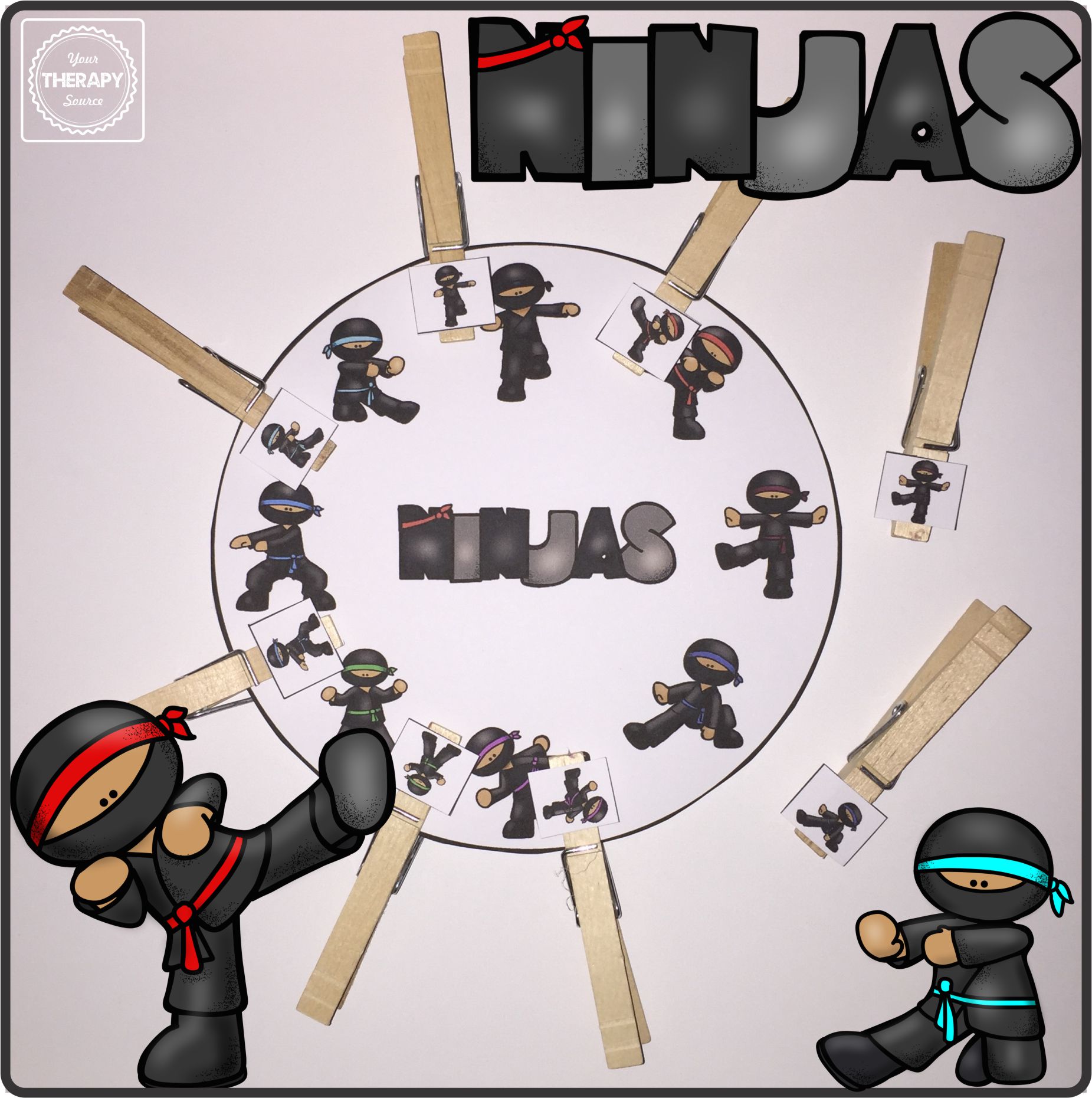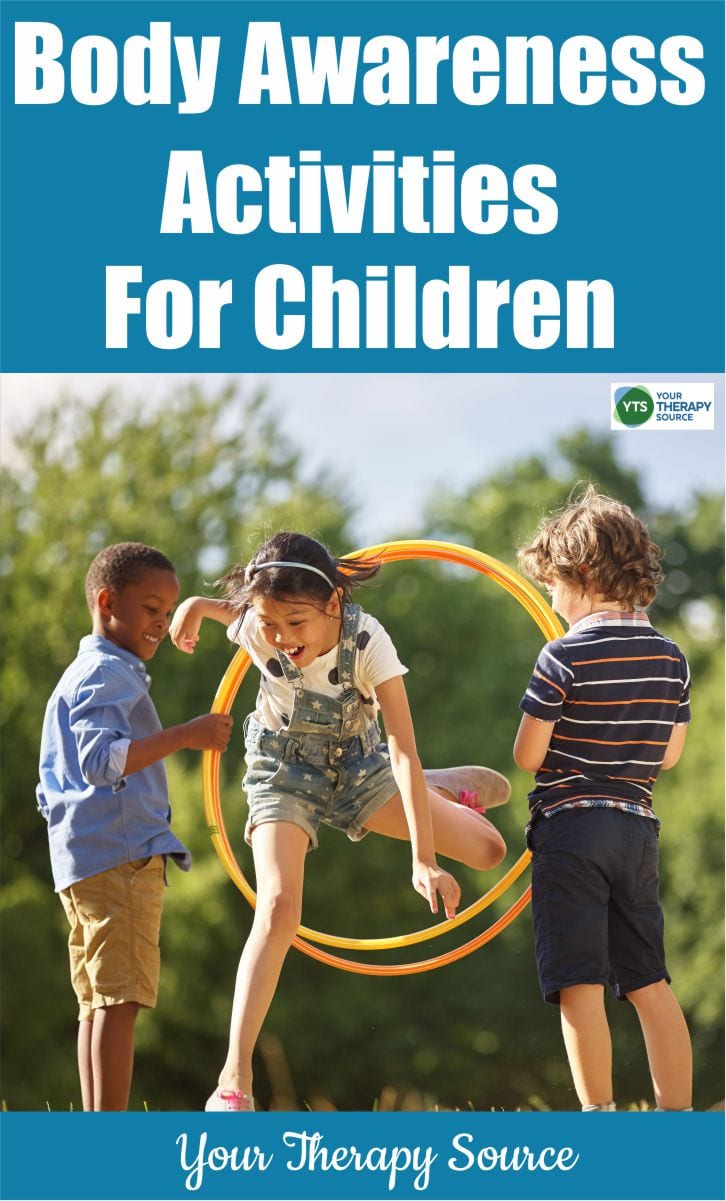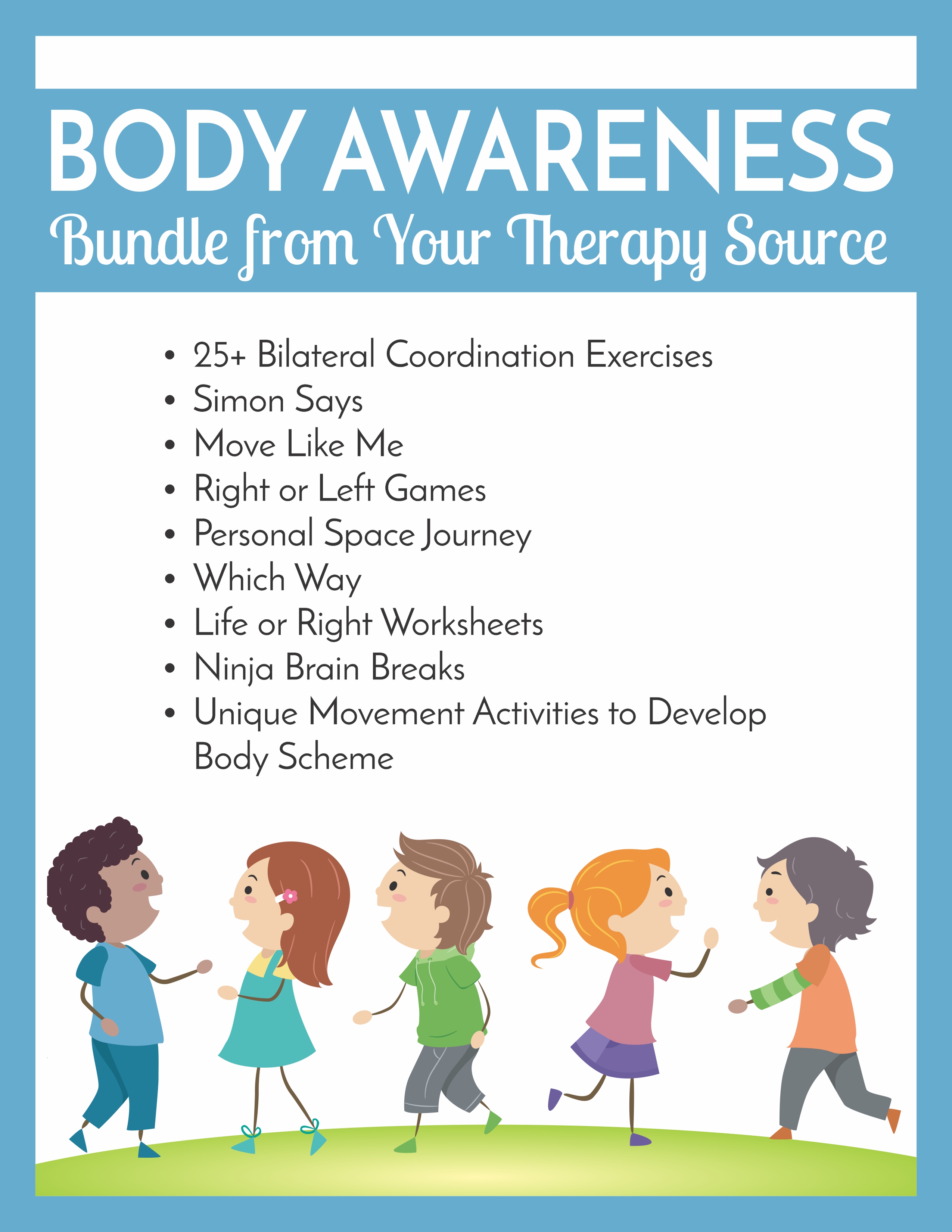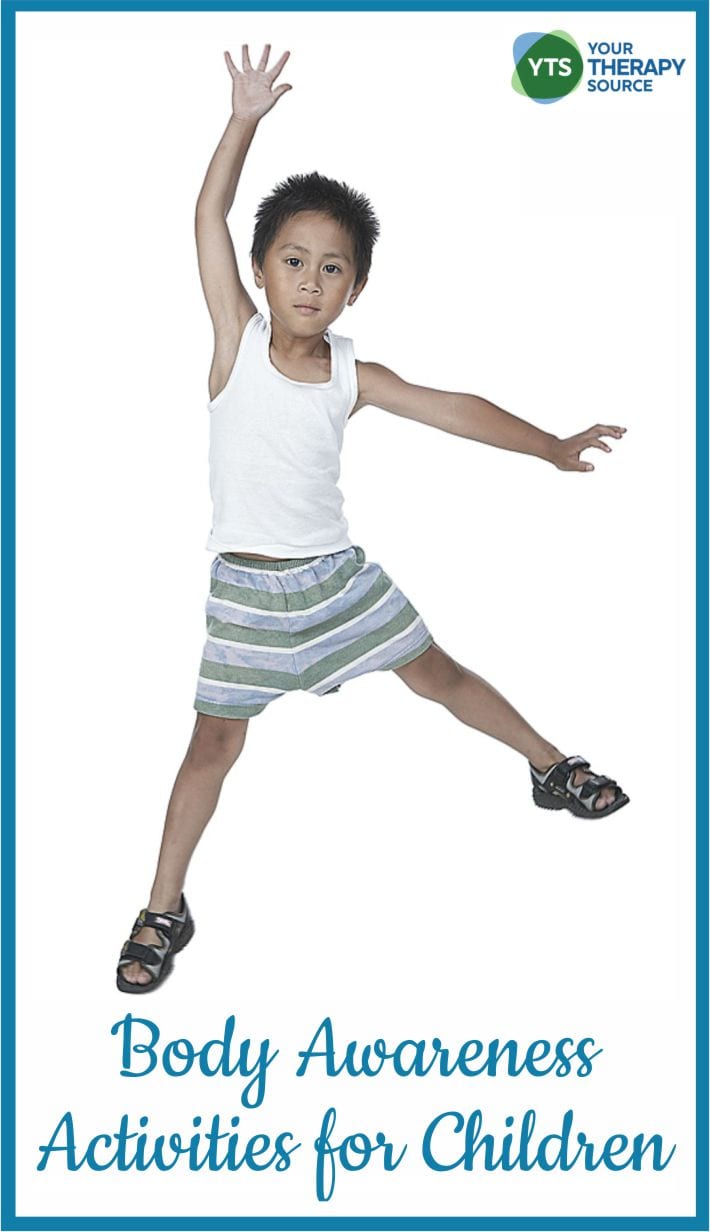Body Awareness Activities for Children
Body awareness definition is the ability to understand where our bodies are in space and how our bodies move. Body awareness activities for children help us to understand how to relate to objects and people at home, at school and outdoors. For example, proper body awareness tells us how far to reach for objects or how close to stand next to a person. Sometimes, if people have difficulties with body awareness they may appear clumsy, uncoordinated or have delays in motor skill development.
Body awareness activities for children
All children may not have the same abilities to interpret and form a motor action when it comes to body awareness. This can results in them in having difficulties with personal space, following motor directions, participating in sports and more. During the school day, body awareness is very important during physical education, recess, walking in a line, playing with friends, etc.
Physical or occupational therapy may be able to help children in this domain if there are deficits. If your child already receives OT or PT, work with your providers to develop body awareness goals in occupational therapy or physical therapy.
Need body awareness examples for kids? Try some of these out below to help teach your students how to develop body awareness.
Proprioceptive input (heavy work activities)
This type of input gives our muscles and joints information about how our arms, legs, head and trunk move. Any weight bearing activities are technically proprioceptive input. Here are some examples: wheelbarrow walking, jumping, stomping the feet, push ups, pushing/pulling, carrying heavy objects, etc.
Play games that involve identifying body parts
Simon Says is a wonderful game to encourage body awareness and self-regulation. Call out more than one activity to increase the challenge such as “Simon Says touch your right hand to your left knee”. Check out these free Simon Says cards.
How to Develop Body Awareness with Mirror Games
Give each child a partner. When one person moves the other person has to copy their movements exactly. Have children try to mimic poses of different movements with these body position cards. Try copying the exact actions of the children pictured in the Move Like Me cards. This packet can help students learn how to develop body awareness.
Practice spatial awareness.
Set up obstacles courses for children to go under, over, through and around objects. This helps children develop an awareness of body in space. Here are more ideas for spatial awareness examples.
Body Awareness Exercises – Beanbag Alphabet Game
Beanbag Alphabet Fun Game used beanbags as a wonderful tool to encourage physical activity, body awareness, motor planning, and coordination skills in children. Move through the alphabet with your beanbag – download this freebie and learn how to play.
Body Awareness Printables
Download this FREE 6 page printable to reinforce body awareness in children and play games.
Ninja Motor Planning and Body Awareness Freebie
Here is a fun FREEBIE for the Ninja loving fan from Ninja Brain Breaks! This activity encourages motor planning, body awareness, finger strengthening, and physical activity. You can download the Ninja Clothes Pin Clip Activity here.
Hula Hoop Game Body Awareness Activities for Children
Through the Hoop – Break up the group into several small teams (about 3 children in each group). Give each group one hula hoop. Establish a starting line and another line about 10-20 feet away. The first person in each group runs to the line that is 10-20 feet away and holds the hoop several inches off the ground. Then the next person runs down, climbs through the hoop and back to the starting line. The third person runs down, climbs through the hoop and back to the starting line. The first person climbs through the hoop while holding it and runs back to start. The first team with all three players through the hoop is the winner.
Creating Self-Portraits
Practice drawing pictures of people or ask the child to draw a picture of himself or herself. Name body parts as they are drawn.
Movement Activities for Kids and Group Body Awareness Activities in the Classroom
Need a quick body awareness and spatial relationship brain break that combines estimation with movement and motor planning? Here is a simple activity that helps students to understand spatial relationships to objects in the classroom.
Start out with each student standing up next to their desk. Have them guess how many baby steps it will take to walk to the desk in front of them. Once they have made the estimate, they can count the baby steps it takes.
Now try moving to a target further away with a different movement. Guess how many jumps it will take to get to the window. Once the estimate is made, the students can count the jumps it takes them to get to the window. Return to the starting point. Now ask the students to double the number of jumps it took them to get to the window. The students must now adjust the size of the jumps and how the body moves through space to take double the amount of jumps to the window.
Have the students partner up. The students can stand at least 10 feet apart. Estimate how many hops it will take to meet in the middle. Test your guess and hop to meet in the middle. Try again with different movements – ie backward steps, heel to toe walking, lunges, marching etc. Make sure to remind the students that part of the challenge is to meet in the middle but not to touch each other.
Q and A Body Awareness Activities for Children
This game can be played with one player or a group of children to promote body awareness, motor skills, and listening skills.
The adult faces the group and is going to ask the children to move certain body parts based on questions. The children are not to answer the questions. They should move the body part that is the answer to the question.
Here is an example:
Question: What body part waves hello?
Answer: Children wave hands in air.
Here is a list of several questions and answers or make up your own. See what questions the children can come up with.
Q: What body part makes funny faces?
A: Child moves mouth or tongue
Q: What body part wears socks?
A: Child moves feet.
Q: What body part uses crayons?
A: Child wiggles fingers.
Q: What body part smells skunks?
A: Child moves nose.
Q: What body part climbs ladders?
A: Child moves arms and legs
Now change the game and request actions based on different noises:
Make a clapping sound with your body.
Stomp your feet
Snap fingers
March in place
Smack lips
Slap knees
Tap shoulders quietly
Now have children close their eyes. Make one of the sounds with your body that you practiced together. Can the children guess what body part you are using to make the sound.
Print the body awareness activities pdf here.
Simon Says Motor Memory Game
Do you need a challenging motor memory and body awareness activity? This Simon Says Motor Memory Challenge game is a super easy activity to prepare although it is not so super easy to play. Challenge yourself to see if you can remember all the moves.
Here is how you play:
- Download and print the Simon Says Motor Memory Challenge game below.
- Cut apart the 10 strips on the page.
- Stack the strips with action #1 at the top.
- Staple the strips together to form a thin “book” of strips.
- Perform action #1: Tap your head with both hands 2 times.
- Turn the page and without looking back, perform action #1 followed by action #2. Tap your head with both hands 2 times and touch both hands to your right knee.
- Turn the page and without looking back perform three actions: Tap your head with both hands 2 times, touch both hands to your right knee AND jump up three times.
- Continue to move through the book remembering each of the actions and adding the new one.
- Can you remember all 10 actions?
DOWNLOAD YOUR FREE BODY AWARENESS ACTIVITIES PDF – SIMON SAYS MOTOR MEMORY CHALLENGE HERE.
Simon Says Exercise Ball Style
Have you ever played Simon Says exercise ball style? This is an easy way to adapt a timeless game of Simon Says but add in more range of motion, muscle strengthening and spatial relationships. It is more of a challenge when you use a large, exercise ball but if that is not available grab a large beach ball which is lighter weight. No beach balls available? Grab a kickball or playground ball? No balls available? Grab a pillow. Just grab something large enough that requires two hands to hold.
Give each child playing an exercise ball or a large beach ball. Provide the usual directions of a Simon Says game but add in some additional steps. For example “Simon says….”
- Put the ball over your head.
- Hold the ball on your right side.
- Hold the ball on your left side.
- Squeeze the ball between your knees.
- Put the ball behind your back.
- Sit on the ball.
- Roll on your belly over the ball.
- Put the ball on top of the desk.
- Hold the ball next to the chair.
- Place the ball between your back and the wall.
- Touch your left foot on the ball.
- Put both hands on the side of the ball.
- Place your right foot under the ball.
- Touch the ball with your left foot, right hand and your chin.
- Bounce the ball three times.
Other Ideas for Simon Says Exercise Ball Body Awareness Activities for Children
By adding in the extra location directions you are also reinforcing right versus left and spatial relationships. The large ball encourages bilateral skills and crossing midline. Simon Says incorporates body awareness, motor planning, crossing midline and balance.
Working with a group of children and only have one large ball? Play hot potato. Remind the children they always have to hold the ball with two hands (or two feet)! Position the children in standing in a large circle with some space between each child. Turn the music on and pass the ball around the circle. Try passing it to the right, to the left or overhead. Try sitting down and passing the ball using your feet.
The Simon Says download includes 68 body position cards (full page), 13 Simon Says Stop cards and 25 game ideas to use with the Simon Says cards. It also includes all the 81 picture cards in a smaller size (2.5″ by 3.25″ – nine cards to one page). Print the cards or play the Simon Says game using the electronic PDF on a screen or a tablet. This activity encourages body awareness, bilateral coordination, motor planning and following directions.
Bonus Tip for How to Develop Body Awareness: Take Some Time to Explore New Spaces
When children have difficulties of sensing where a child is in space can interfere with motor skill development, peer interaction, and safety. When new skills are being learned take some time to fully explore the environment where the functional skills are to be learned. Children need to explore and practice skills in the actual environment where they need to have appropriate body awareness.
Take for example a student who is bumping into objects or peers in the classroom. When the classroom is empty, go inside and have the student walk in and around the desks and chairs. Practice crawling under desks, kneeling down and sitting in different locations in the classroom. Add in games or activities to keep it novel. Provide verbal cues as the student walks by items if necessary ie. this desk is wide or this aisle is narrow. This exploration allows the child to develop a motor map of his surroundings with him in it. This helps to develop a better sense of how big desks are, how tall are the chairs, how wide is the carpet and how far is the bathroom.
This can apply to different areas of the school or home. How about the cafeteria? Let a child explore it to help define a motor map for in between cafeteria tables, on the cafeteria line and around garbage cans. At home, if the furniture is changed around allow time to just explore the new areas and obstacles without adding in the stressors of different goals.
Keep it simple sometimes and start out with just simply exploring the surroundings without adding in any other functional tasks to help build a strong foundation.
Need More Resources Body Awareness Activities for Children?
The Body Awareness Bundle from Your Therapy Source includes 9 amazing resources to help children develop body awareness, motor planning, and coordination skills. All 9 digital resources will be available electronically immediately following payment. Download this Crossing Midline body awareness freebie below to get an awesome coupon for the Body Awareness Bundle.
Click on each title for more details:
25+ Bilateral Coordination Exercises: Download of 28 bilateral coordination exercise sheets including QR codes with links to a video demonstration of exercises. Also includes hand out explaining bilateral coordination. ($8.99)
Simon Says: This download includes 68 body position cards (full page), 13 Simon Says Stop cards and 25 game ideas to use with the Simon Says cards. It also includes all the 81 picture cards in a smaller size (2.5″ by 3.25″ – nine cards to one page). Print the cards or play the Simon Says game using the electronic PDF on a screen or a tablet. This activity encourages body awareness, bilateral coordination, motor planning and following directions. ($6.99)
Move Like Me: Download includes action poses for children to practice motor planning, crossing midline, body awareness, timing, rhythm, coordination and physical activity. ($4.99)
Right or Left Games digital packet helps children to practice right and left discrimination, bilateral coordination, fine motor skills, balance skills, body awareness, motor planning and visual-spatial skills. ($5.99)
Personal Space Journey: Collection of activities to teach children about personal space including many body awareness exercises and a social story on personal space ($8.99)
Which Way? includes 16 directional arrow pages (large and small size) plus 6 boards to follow. The activities are available in varying degrees of difficulty. Children will practice moving right, left, diagonally, forwards, backwards, clockwise, down and up. Practice motor planning skills, visually scanning from right to left, understanding prepositional phrases and spatial awareness with this movement activity. ($2.99)
Laterality Exercises – Left or Right Worksheets digital download includes 20 black and white worksheets to help learn the concepts of left and right. Directions include writing from left to right, coloring objects on the left or right, circle the correct direction, handwriting activities and more. Encourage visual-spatial skills. ($4.99)
Ninja Brain Breaks: This download is a collection of 5 games to encourage visual motor skills, fine motor skills, motor planning, body awareness and physical activity. The packet includes Roll Some Ninja Moves, Ninja Clothes Pin Clips, 5 Ninja Lotto Boards, 12 Freeze Dance Ninjas (great for a group), 5 Speed Ninja boards and 12 small Ninja cards. ($3.99)
Unique Movement Oriented Games to Develop Body Scheme – Activities for the Classroom, Clinic, and Home includes instructions, a list of targeted skills, pictures, and cue cards for each of the therapeutic activities. Suggestions are provided on how these activities can be adapted for various developmental levels. The games can be left in the classroom and played as a sensory break, or an inclusive recess activity with peers. The activities can also be adapted to target core curriculum. ($14.95)
RELATED POSTS:
Why Is Body Awareness Important?
Body Awareness Develops Throughout Childhood
Laterality Activities – Laterality is the term used to describe the dominance of one side of the brain over the other. An easy way to figure out your laterality is to analyze your hand dominance.
Directionality Activities– From fun songs to maze games, these lessons will help your students become more familiar with cardinal directions, left-to-right directionality, and more.














Comments are closed.